The Organic Rankine Cycle (ORC) market is projected to grow significantly from USD 21.6 billion in 2025 to approximately USD 87.5 billion by 2035, registering a CAGR of 15.0% during the forecast period. Growth in the early years is supported by rising investments in waste heat recovery, geothermal energy, and biomass-based power generation, alongside the increasing emphasis on industrial energy efficiency and low-carbon technologies.
From 2025 to 2030, the market is expected to expand steadily, with demand driven by the integration of ORC systems into industrial processes and medium-scale renewable energy projects. In the latter half of the forecast, from 2030 to 2035, growth is expected to accelerate, fueled by wider adoption in combined heat and power (CHP) systems, remote off-grid power generation, and large-scale waste-to-energy initiatives.
This strong expansion is underpinned by advancements in working fluids, compact heat exchangers, modular plant design, and supportive energy policies. As industries and governments continue to prioritize decarbonization and energy recovery, the ORC market is positioned to play a central role in global renewable and sustainable energy transitions.
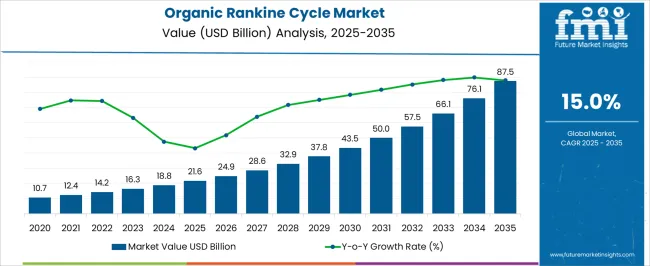
| Metric | Value |
|---|---|
| Organic Rankine Cycle Market Estimated Value in (2025 E) | USD 21.6 billion |
| Organic Rankine Cycle Market Forecast Value in (2035 F) | USD 87.5 billion |
| Forecast CAGR (2025 to 2035) | 15.0% |
The organic Rankine cycle market is experiencing steady growth, underpinned by increasing emphasis on energy efficiency, decarbonization, and the recovery of low-grade heat from industrial processes. Supportive policy frameworks promoting cleaner technologies, along with rising carbon pricing and energy cost volatility, are strengthening the business case for ORC systems across both developed and emerging markets.
The technology’s scalability, low maintenance requirements, and compatibility with diverse heat sources from biomass and geothermal to industrial exhaust are expanding its deployment potential. Industries are prioritizing ORC solutions to improve operational sustainability, particularly where waste heat represents untapped energy.
As grid stability becomes increasingly important, ORC’s ability to offer distributed power generation without combustion is being viewed as a long-term strategic advantage. Future market growth is expected to be catalyzed by ongoing advancements in working fluids, compact heat exchangers, and integration with hybrid renewable systems.
The Organic Rankine cycle (ORC) market is segmented by power output, application, and geographic regions. By power output, the market is divided into ≤1 MWe, >1–5 MWe, >5–10 MWe, and >10 MWe. In terms of application, the market is classified into Waste Heat Recovery, Biomass, Geothermal, Solar Thermal, Oil & Gas, and Waste to Energy. Regionally, the ORC industry is segmented into North America, Latin America, Western Europe, Eastern Europe, Balkan & Baltic Countries, Russia & Belarus, Central Asia, East Asia, South Asia & Pacific, and the Middle East & Africa.

The >1–5 MWe capacity range is projected to account for 36.40% of total revenue in the ORC market by 2025, making it the dominant power output segment. This position is being reinforced by the segment’s suitability for medium-scale industrial and municipal applications, where operational efficiency and modular scalability are key.
The flexibility of this range allows for deployment in decentralized energy projects, where grid independence and waste heat utilization intersect. Additionally, the segment aligns well with retrofitting needs in aging industrial infrastructure, where available waste heat potential does not justify larger capacity investments.
Its relatively faster payback period, reduced environmental footprint, and ability to integrate into existing energy management systems have made it an attractive solution for a wide range of sectors, from manufacturing to district heating.
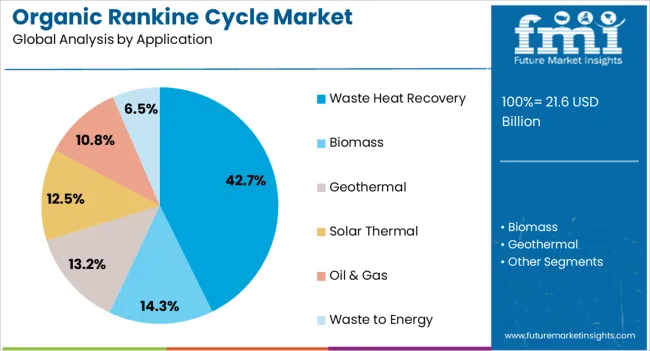
Waste heat recovery is expected to hold 42.70% of the revenue share in the ORC market by 2025, making it the leading application segment. The dominance of this segment is being driven by global efforts to reduce industrial emissions and maximize energy efficiency.
ORC technology is well-suited for capturing low- to medium-temperature waste heat from processes such as metal smelting, cement production, and internal combustion engines, converting it into useful electricity without additional fuel consumption. Regulatory incentives and rising energy costs are encouraging manufacturers to recover lost thermal energy to improve profitability.
As industries face increasing pressure to decarbonize operations and report on environmental performance, the integration of ORC systems for waste heat recovery is being prioritized. Furthermore, the ability of these systems to operate reliably in harsh environments with minimal maintenance requirements is bolstering adoption across continuous-process industries.
The organic rankine cycle market is expanding due to its growing adoption in waste heat recovery, renewable energy, and distributed energy applications. Continuous technological improvements and market diversification are further supporting its growth.
The organic rankine cycle (ORC) market is experiencing significant growth due to the increasing adoption of waste heat recovery systems across various industries. These systems are being integrated into manufacturing facilities, refineries, and cement plants to convert low-grade heat into usable power. As industries seek to reduce energy consumption and operational costs, ORC technology provides an efficient solution to harness waste heat that would otherwise be lost. The demand for such systems is expected to rise, particularly in sectors with high thermal energy output. The growing focus on reducing energy wastage and optimizing plant efficiency supports the expansion of ORC solutions in industrial settings.
In renewable energy sectors, organic rankine cycle systems are gaining traction in geothermal and biomass power generation. The ability of ORC technology to utilize lower-temperature geothermal resources effectively positions it as a key player in geothermal power plants, particularly in regions with moderate heat sources. Furthermore, ORC systems are integrated into biomass plants, where they convert organic waste into electricity, contributing to cleaner energy production. This demand is being driven by governmental incentives, increasing market competitiveness, and the shift towards renewable power sources. As renewable energy goals become more critical globally, the ORC market is well-positioned to benefit from rising investments in alternative energy solutions.
Organic rankine cycle systems are increasingly being deployed in distributed energy generation applications, particularly in off-grid areas. These systems provide a reliable and cost-effective solution for producing electricity from waste heat or renewable resources in remote locations where grid access is limited. As demand for decentralized power generation grows, ORC technologies are being utilized to supply power to rural and off-grid communities, especially in remote industrial sites. This trend is supported by governments and private organizations seeking to improve energy access in underserved regions. The adoption of ORC systems in these markets is helping diversify energy generation methods and improve power reliability.
The organic rankine cycle market is also benefiting from continuous technological advancements that enhance system efficiency and reduce costs. Manufacturers are focusing on improving the performance of ORC systems through better working fluids, enhanced heat exchanger designs, and modular plant configurations that reduce installation time and costs. These innovations are making ORC systems more economically viable for smaller-scale applications. As competition in the market intensifies, companies are also exploring new geographic regions and industries for potential expansion. These developments are expanding the market’s reach and making ORC solutions more accessible to a broader range of customers.
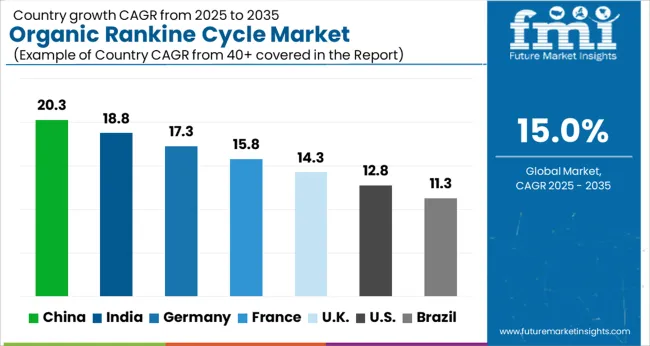
The organic rankine cycle market is projected to grow globally at a CAGR of 15.0% from 2025 to 2035, driven by increasing demand for energy efficiency, waste heat recovery, and renewable energy solutions. China leads with a CAGR of 20.3%, propelled by extensive industrial applications and investments in geothermal and biomass energy projects. India follows at 18.8%, fueled by the rapid growth of industrial infrastructure and government incentives for renewable energy. Germany records a growth rate of 17.3%, supported by high demand for waste heat recovery systems in manufacturing and energy-intensive sectors. France posts 15.8% growth, benefiting from its focus on energy efficiency and low-carbon technologies. The UK achieves 14.3%, driven by investments in renewable energy and decentralized power generation systems. The USA achieves 12.8%, influenced by expanding adoption of ORC systems in the industrial and waste-to-energy sectors, aiming to enhance energy recovery and sustainability.
The CAGR for the organic rankine cycle market in the United Kingdom was estimated at 7.5% during 2020–2024 and advanced to 14.3% between 2025 and 2035, signaling stronger adoption of ORC systems in renewable energy and waste heat recovery. Early growth was moderate, driven by the initial integration of ORC technology in industrial applications. In the next phase, the demand for ORC systems surged due to the growing emphasis on energy efficiency and carbon reduction strategies. Increased investments in renewable energy projects and decentralized power generation systems further boosted market adoption. Government incentives for clean energy solutions strengthened the momentum of ORC technology deployment.
India’s CAGR for the organic rankine cycle market was 11.1% during 2020–2024 and is projected to rise to 18.8% from 2025 to 2035. The early growth was driven by India’s expanding industrial sector and the increasing need for energy-efficient solutions. During the 2020–2024 period, ORC systems were primarily adopted in medium-scale renewable energy and waste heat recovery applications. As India’s government introduced initiatives to boost renewable energy integration and reduce carbon emissions, demand for ORC systems grew. The shift towards cleaner energy solutions and decentralized power generation further fueled ORC market growth, positioning India as a key player in the global market.
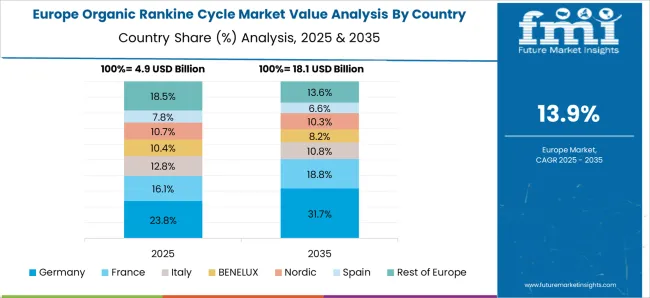
France’s CAGR for the organic rankine cycle market was estimated at 9.0% during 2020–2024 and is expected to increase to 15.8% during 2025–2035. The early growth was driven by moderate adoption of ORC systems in small- and medium-scale biomass and geothermal plants. France’s ambitious energy transition plan aimed at reducing fossil fuel dependency and improving energy efficiency significantly influenced the growth of ORC technology in the country. The French government’s support for renewable energy projects and the integration of ORC systems for waste heat recovery in industrial facilities further accelerated market growth. By 2025, ORC technology became essential for achieving France’s energy goals.
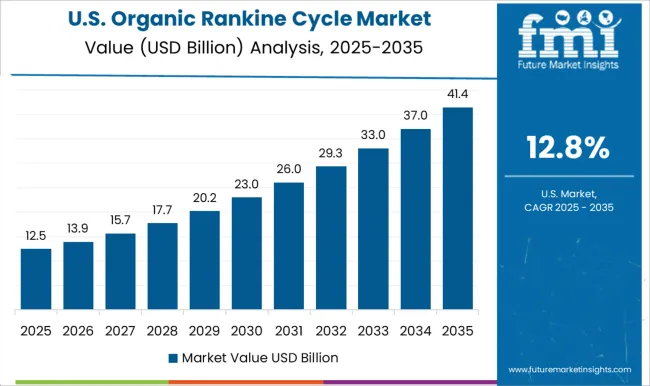
The CAGR for the organic rankine cycle market in the United States was 8.0% from 2020 to 2024 and is projected to rise to 12.8% during the 2025 to 2035 period. Early growth was driven by the increasing interest in waste heat recovery in industrial sectors, particularly in manufacturing. The USA saw steady adoption of ORC systems as industries focused on improving energy efficiency and reducing operational costs. As energy transition efforts gained momentum, the market for ORC systems expanded, especially in geothermal and biomass power generation. The growing emphasis on reducing carbon emissions and improving energy recovery further strengthened demand by 2025.
China’s CAGR for the organic rankine cycle market was 12.6% during 2020–2024 and surged to 20.3% for 2025–2035, reflecting China’s aggressive investment in renewable energy and waste heat recovery systems. Early growth was moderate, with China focusing on waste heat recovery in large industrial sectors. In the next phase, ORC technology gained traction due to the country’s growing demand for low-temperature geothermal energy and renewable power generation. China’s emphasis on energy efficiency and reduction of carbon emissions further accelerated the adoption of ORC systems. Government incentives, combined with the large-scale adoption of ORC technology in renewable and industrial applications, positioned China as a market leader.
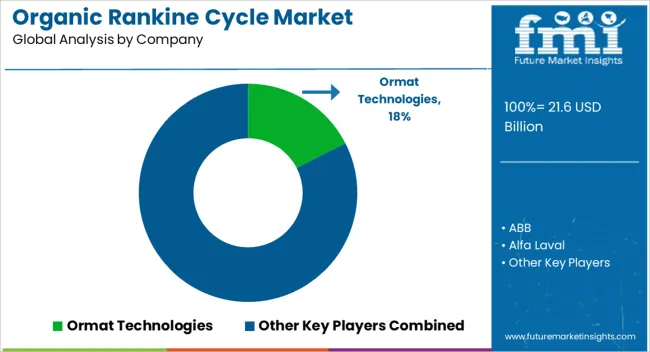
The organic rankine cycle market is highly competitive, featuring a mix of multinational giants and regional players, with companies like Ormat Technologies, ABB, and General Electric at the forefront. Ormat Technologies is a leader in developing ORC solutions for geothermal and waste heat recovery applications, leveraging its strong expertise in energy systems. ABB, known for its industrial automation technologies, focuses on integrating ORC systems with advanced control and monitoring solutions.
Alfa Laval and Atlas Copco are prominent for their thermal management systems, providing heat exchangers and ORC generators for energy recovery applications. Key players like Calnetix Technologies and Turboden specialize in optimizing ORC systems for low-temperature and waste heat recovery, while Mitsubishi Heavy Industries and Kaishan USA focus on providing energy-efficient ORC technologies for industrial applications.
Companies such as Elvosolar and Triogen work towards enhancing the integration of ORC systems in solar and biomass energy plants, contributing to expanding the renewable energy footprint of ORC solutions. Differentiation strategies focus on enhancing ORC efficiency, modular designs, and improving heat exchanger technologies. Players in the market are expanding their portfolios by forming strategic alliances, particularly in geothermal and industrial waste heat recovery sectors, to strengthen their position in the growing demand for renewable energy and energy-efficient technologies.
| Item | Value |
|---|---|
| Quantitative Units | USD Billion |
| Power Output | > 1 - 5 MWe, ≤ 1 MWe, > 5 - 10 MWe, and > 10 MWe |
| Application | Waste Heat Recovery, Biomass, Geothermal, Solar Thermal, Oil & Gas, and Waste to Energy |
| Regions Covered | North America, Europe, Asia-Pacific, Latin America, Middle East & Africa |
| Country Covered | United States, Canada, Germany, France, United Kingdom, China, Japan, India, Brazil, South Africa |
| Key Companies Profiled | Ormat Technologies, ABB, Alfa Laval, Atlas Copco, Calnetix Technologies, Elvosolar, Enertime, Energia, Exergy International, General Electric, Intec GMK, Kaishan USA, Mitsubishi Heavy Industries, Orchan Energy, Triogen, Turboden |
| Additional Attributes | Dollar sales projections, market share by region, growth rate by industry, key players, competitive landscape, regulatory trends, emerging technologies, demand for ORC in waste heat recovery, geothermal, biomass, and industrial sectors. |
The global organic rankine cycle market is estimated to be valued at USD 21.6 billion in 2025.
The market size for the organic rankine cycle market is projected to reach USD 87.5 billion by 2035.
The organic rankine cycle market is expected to grow at a 15.0% CAGR between 2025 and 2035.
The key product types in organic rankine cycle market are > 1 - 5 mwe, ≤ 1 mwe, > 5 - 10 mwe and > 10 mwe.
In terms of application, waste heat recovery segment to command 42.7% share in the organic rankine cycle market in 2025.






Our Research Products

The "Full Research Suite" delivers actionable market intel, deep dives on markets or technologies, so clients act faster, cut risk, and unlock growth.

The Leaderboard benchmarks and ranks top vendors, classifying them as Established Leaders, Leading Challengers, or Disruptors & Challengers.

Locates where complements amplify value and substitutes erode it, forecasting net impact by horizon

We deliver granular, decision-grade intel: market sizing, 5-year forecasts, pricing, adoption, usage, revenue, and operational KPIs—plus competitor tracking, regulation, and value chains—across 60 countries broadly.

Spot the shifts before they hit your P&L. We track inflection points, adoption curves, pricing moves, and ecosystem plays to show where demand is heading, why it is changing, and what to do next across high-growth markets and disruptive tech

Real-time reads of user behavior. We track shifting priorities, perceptions of today’s and next-gen services, and provider experience, then pace how fast tech moves from trial to adoption, blending buyer, consumer, and channel inputs with social signals (#WhySwitch, #UX).

Partner with our analyst team to build a custom report designed around your business priorities. From analysing market trends to assessing competitors or crafting bespoke datasets, we tailor insights to your needs.
Supplier Intelligence
Discovery & Profiling
Capacity & Footprint
Performance & Risk
Compliance & Governance
Commercial Readiness
Who Supplies Whom
Scorecards & Shortlists
Playbooks & Docs
Category Intelligence
Definition & Scope
Demand & Use Cases
Cost Drivers
Market Structure
Supply Chain Map
Trade & Policy
Operating Norms
Deliverables
Buyer Intelligence
Account Basics
Spend & Scope
Procurement Model
Vendor Requirements
Terms & Policies
Entry Strategy
Pain Points & Triggers
Outputs
Pricing Analysis
Benchmarks
Trends
Should-Cost
Indexation
Landed Cost
Commercial Terms
Deliverables
Brand Analysis
Positioning & Value Prop
Share & Presence
Customer Evidence
Go-to-Market
Digital & Reputation
Compliance & Trust
KPIs & Gaps
Outputs
Full Research Suite comprises of:
Market outlook & trends analysis
Interviews & case studies
Strategic recommendations
Vendor profiles & capabilities analysis
5-year forecasts
8 regions and 60+ country-level data splits
Market segment data splits
12 months of continuous data updates
DELIVERED AS:
PDF EXCEL ONLINE
Organic Cosmetics Market Size and Share Forecast Outlook 2025 to 2035
Organic Salad Dressing Market Forecast and Outlook 2025 to 2035
Organic Fertilizer Market Size and Share Forecast Outlook 2025 to 2035
Organic Acai Juice Market Size and Share Forecast Outlook 2025 to 2035
Organic Beverages Market Size and Share Forecast Outlook 2025 to 2035
Organic Drinks Market Size and Share Forecast Outlook 2025 to 2035
Organic Oats Market Size and Share Forecast Outlook 2025 to 2035
Organic Dried Distillers Grain Feed Market Size and Share Forecast Outlook 2025 to 2035
Organic Hemp Market Size and Share Forecast Outlook 2025 to 2035
Organic Electronics Market Size and Share Forecast Outlook 2025 to 2035
Organic Dyes Market Size and Share Forecast Outlook 2025 to 2035
Organic Seed Varieties Market Size and Share Forecast Outlook 2025 to 2035
Organic Lamb Market Size and Share Forecast Outlook 2025 to 2035
Organic Snack Food Market Size and Share Forecast Outlook 2025 to 2035
Organic Rice Protein Market Size and Share Forecast Outlook 2025 to 2035
Organic Hydrosols Market Size and Share Forecast Outlook 2025 to 2035
Organic Trace Minerals Market Analysis - Size, Share, and Forecast Outlook 2025 to 2035
Organic Food and Beverage Market Analysis - Size, Share, and Forecast Outlook 2025 to 2035
Organic Starch Market - Size, Share, and Forecast Outlook 2025 to 2035
Organic Fruit Powder Market Size, Growth, and Forecast for 2025 to 2035

Thank you!
You will receive an email from our Business Development Manager. Please be sure to check your SPAM/JUNK folder too.
Chat With
MaRIA